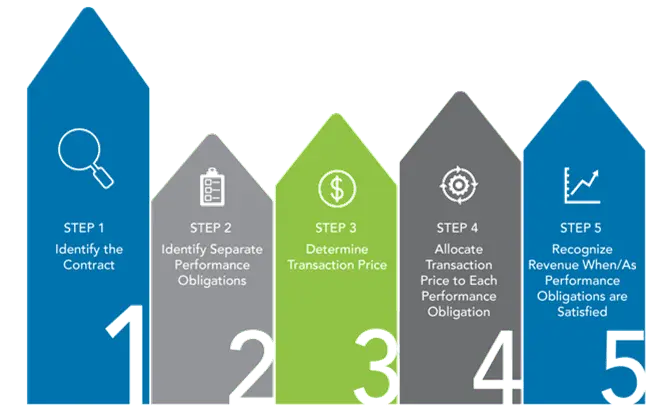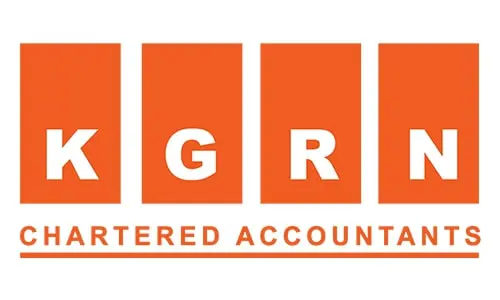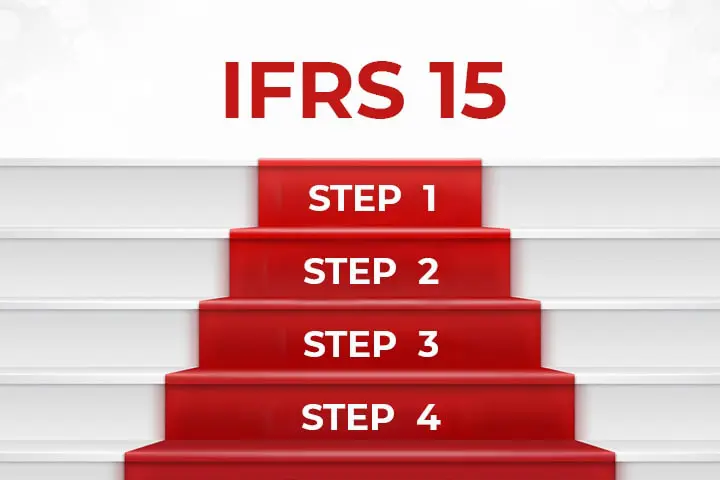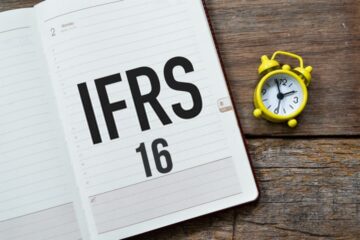IFRS 15 Overview
IFRS 15 determines how and when an IFRS columnist will perceive income just as requiring such substances to furnish clients of financial reports with progressively instructive, important revelations. The standard gives a solitary, standards-based five-advance model to be applied to all agreements with clients.
IFRS 15 Revenue enquires call @ +971 45 570 204 / Email Us : [email protected]
Succeeded Standards
IFRS 15 replaces the accompanying principles and elucidations:
• IAS 11 Construction contracts
• IAS 18 Revenue
• IFRIC 13 Customer Loyalty Programs
• IFRIC 15 Agreements for the Construction of Real Estate
• IFRIC 18 Transfers of Assets from Customers
• SIC-31 Revenue – Barter Transactions Involving Advertising Services
Synopsis of IFRS 15
Objective
The target of IFRS 15 is to set up the rules that an element will apply to report valuable data to clients of financial reports about the nature, sum, timing, and vulnerability of income and incomes emerging from an agreement with a client.
Extension
IFRS 15 Revenue from Contracts with Customers applies to all agreements with clients aside from leases inside the extent of IAS 17 Leases; money related instruments and other legally binding rights or commitments inside the extent of IFRS 9 Financial Instruments, IFRS 10 Consolidated Financial Statements, IFRS 11 Joint Arrangements, IAS 27 Separate Financial Statements and IAS 28 Investments in Associates and Joint Ventures; protection contracts inside the extent of IFRS 4 Insurance Contracts; and non-fiscal trades between elements in a similar line of business to encourage deals to clients or potential clients.
An agreement with a client might be somewhat inside the extent of IFRS 15 and incompletely inside the extent of another standard.
• if different gauges indicate how to isolate as well as at first measure at least one piece of the agreement, at that point those division and estimation necessities are applied first. The exchange cost is then decreased by the sums that are at first estimated under different measures;
• if no other standard gives direction on the most proficient method to isolate as well as at first measure at least one piece of the agreement, at that point IFRS 15 will be applied.
IFRS 15 Revenue enquires call @ +971 45 570 204 / Email Us : [email protected]
IFRS 15 Key definitions
IFRS 15 an understanding between at least two gatherings that makes enforceable rights and commitments
A gathering that has contracted with a substance to get merchandise or administrations that are a yield of the element’s customary exercises in return for thought.
Increments in monetary advantages during the bookkeeping time frame as inflows or upgrades of benefits or diminish of liabilities that outcome in an expansion in value, other than those identifying with commitments from value members.
A IFRS 15 guarantee in an agreement with a client to move to the client either:
• A great or administration (or a heap of merchandise or administrations) that is particular; or
• An arrangement of particular merchandise or administrations that are significantly the equivalent and that have a similar example of the move to the client.
Pay emerging throughout an element’s customary exercises.
The IFRS 15 measure of thought to which a substance hopes to be entitled in return for moving guaranteed products or administrations to a client, barring sums gathered in the interest of outsiders.
Bookkeeping prerequisites for income
The five-advance model system
The center rule of IFRS 15 is that a substance will perceive income to portray the exchange of guaranteed products or administrations to clients in a sum that mirrors the thought to which the element hopes to be entitled in return for those merchandise or administrations. This center guideline is conveyed in a five-advance model system:
• Identify the contract(s) with a client
• Identify the presentation commitments in the agreement
• Determine the exchange cost
• Allocate the exchange cost to the presentation commitments in the agreement
• Recognize income when (or as) the element fulfills a presentation commitment.
The use of this direction will rely upon the realities and conditions present in an agreement with a client and will require the activity of judgment.
Stage 1: Identify the agreement with the client
An agreement with a client will be inside the extent of IFRS 15 if all the accompanying conditions are met:
• The contract hosts have been affirmed by the gatherings to the agreement;
• Each gathering’s privileges in connection to the products or administrations to be moved can be recognized;
• The installment terms for the merchandise or administrations to be moved can be distinguished;
• The contract has business substance; and
• Likely, the thought to which the substance is qualified for in return for the products or administrations will be gathered.
If an agreement with a client doesn’t yet meet the entirety of the above criteria, the element will keep on re-evaluate the agreement going ahead to decide if it in this way meets the above criteria. Starting there, the element will apply IFRS 15 to the agreement.
The IFRS 15 standard gives nitty-gritty direction on the best way to represent endorsed contract alterations. If specific conditions are met, an agreement alteration will be represented as a different agreement with the client. If not, it will be represented by changing the representing the present agreement with the client. Regardless of whether the last sort of change is represented tentatively or reflectively relies upon whether the rest of the merchandise or administrations to be conveyed after the adjustment are particular from those conveyed preceding the alteration. Further subtleties on representing contract alterations can be found in the Standard.
Stage 2: Identify the presentation commitments in the agreement
At the beginning of the agreement, the element ought to survey the merchandise or administrations that have been guaranteed to the client, and distinguish as an exhibition commitment:
• A great or administration (or heap of merchandise or administrations) that is particular; or
• An arrangement of unmistakable merchandise or administrations that are considered the equivalent and that have a similar example of the move to the client.
A progression of unmistakable products or administrations is moved to the client in a similar example if both of the accompanying criteria are met:
• Each particular great or administration in the arrangement that the element vows to move continuously to the client would be a presentation commitment that is fulfilled after some time (see underneath); and
• a single strategy for estimating progress would be utilized to gauge the element’s advancement towards complete fulfillment of the presentation commitment to move each unmistakable great or administration in the arrangement to the client.
A decent or administration is particular if both of the accompanying criteria are met:
• The client can profit by the great or administrations all alone or related to other promptly accessible assets; and
• The elements guaranteed to move the great or administration to the client is independently identifiable from different guarantees in the agreement.
Variables for thought regarding whether a guarantee to move merchandise or administrations to the client isn’t independently recognizable incorporate, yet are not restricted to:
• The substance provides a huge help of incorporating the products or administrations with different merchandise or administrations guaranteed in the agreement;
• The products or administrations altogether adjust or redo different merchandise or administrations guaranteed in the agreement;
• The products or administrations are profoundly interrelated or exceptionally related.
Stage 3: Determine the exchange cost
The IFRS 15 exchange cost is the sum to which a substance hopes to be entitled in return for the exchange of merchandise and ventures. When making this assurance, an element will consider past standard strategic policies.
Where an agreement contains components of variable thought, the element will evaluate the measure of variable thought to which it will be entitled under the agreement. IFRS 15 Variable thought can emerge, for instance, because of limits, discounts, discounts, credits, value concessions, motivators, execution rewards, punishments or other comparable things. Variable thought is additionally present if an element’s entitlement to thought is dependent upon the event of a future occasion.
The IFRS 15 standard arrangements with the vulnerability identifying with variable thought by constraining the measure of variable thought that can be perceived. In particular, factor thought is possibly remembered for the exchange cost if, and to the degree that, it is profoundly plausible that its incorporation won’t bring about a huge income inversion later on when the vulnerability has been in this way settled.
In any case, an alternate, progressively prohibitive methodology is applied regarding offers or utilization based eminence income emerging from licenses of protected innovation. Such income is perceived just when the fundamental deals or use happen.
Stage 4: Allocate the exchange cost to the exhibition commitments in the agreements
Where IFRS 15 an agreement has various execution commitments, an element will distribute the exchange cost to the presentation commitments in the agreement by reference to their relative independent selling costs. On the off chance that an independent selling cost isn’t legitimately perceptible, the substance should appraise it.
IFRS 15 recommends different techniques that may be utilized, including:
• An adjusted showcase evaluation approach
• Expected cost in addition to an edge approach
• Residual approach (just reasonable in constrained conditions).
Any general rebate contrasted with the total of independent selling costs is allotted between execution commitments on a relative independent selling value premise. In specific conditions, it might be suitable to assign such a markdown to a few yet not the entirety of the presentation commitments
Where thought is paid ahead of time or financially past due, the substance should think about whether the agreement incorporates a critical financing game plan and, provided that this is true, change for the time estimation of cash. A down to earth convenient is accessible where the interim between the move of the guaranteed merchandise or administrations and installment by the client is relied upon to be under a year.
Stage 5: Recognize income when (or as) the element fulfills an exhibition commitment
Income is perceived as control is spent, either after some time or at a point in time.
Control of an advantage is characterized as the capacity to coordinate the utilization of and get generously the entirety of the rest of the advantages from the benefit. This incorporates the capacity to keep others from coordinating the utilization of and acquiring the advantages from the benefit. The advantages identified with the benefit are the potential incomes that might be acquired straightforwardly or by implication.
These incorporate, yet are not restricted to:
• using the advantage of produce products or give administrations;
• using the advantage of upgrade the estimation of different resources;
• using the advantage for settle liabilities or to lessen costs;
• selling or trading the advantage;
• pledging the advantage for secure a credit; and
• holding the advantage.
An element perceives income after some time on the off chance that one of the accompanying criteria is met:
• The client at the same time gets and expends the entirety of the advantages gave by the substance as the element performs;
• The element’s exhibition makes or upgrades an advantage that the client controls as the benefit is made; or
• The element’s exhibition doesn’t make a benefit with an elective use to the element and the element has an enforceable right to installment for execution finished to date.
If a substance doesn’t fulfill its presentation commitment after some time, it fulfills it at a point in time. Income will consequently be perceived when control is passed at one point in time. Variables that may demonstrate the point in time at which control passes incorporate, yet are not constrained to the substance has a present right to installment for the advantage;
• The client has a legitimate title to the advantage;
• The substance has moved physical ownership of the advantage;
• The client has the critical dangers and prizes identified with the responsibility for resource; and
• The client has acknowledged the advantage.
IFRS 15 Revenue enquires call @ +971 45 570 204 / Email Us : [email protected]
Agreement costs
The IFRS 15 steady expenses of getting an agreement must be perceived as a benefit if the substance hopes to recoup those expenses. In any case, those gradual expenses are restricted to the costs that the element would not have brought about if the agreement had not been effectively gotten (for example ‘achievement expenses’ paid to operators). A useful catalyst is accessible, permitting the gradual expenses of acquiring an agreement to be expensed if the related amortization time frame would be a year or less.
Expenses brought about to satisfy an agreement is perceived as a benefit if and just if the entirety of the accompanying criteria is met:
• The costs relate straightforwardly to an agreement (or a particular foreseen contract);
• The costs create or upgrade assets of the substance that will be utilized in fulfilling execution commitments later on; and
• The costs are relied upon to be recouped.
These incorporate costs, for example, direct work, direct materials, and the designation of overheads that relate legitimately to the agreement.
The advantage perceived regarding the expenses to get or satisfy an agreement is amortized on an orderly premise that is steady with the example of the move of the products or administrations to which the benefit relates.
Further helpful execution direction in connection to applying IFRS 15
These subjects include:
• Performance commitments fulfilled after some time
• Methods for estimating progress towards complete fulfillment of a presentation commitment
• Sale with the privilege of return
• Warranties
• Principal versus operator contemplations
• Customer choices for extra merchandise or administrations
• Customers’ unexercised rights
• Non-refundable forthright expenses
• Licensing
• Repurchase plans
• Consignment game plans
• Bill-and-hold game plans
• Customer acknowledgment
• Disclosures of disaggregation of income
These themes ought to be considered cautiously while applying IFRS 15.
Introduction in financial reports
Agreements with clients will be exhibited in an element’s announcement of the monetary situation as an agreement risk, an agreement resource, or a receivable, contingent upon the connection between the substance’s presentation and the client’s installment.
An agreement obligation IFRS 15 is introduced in the announcement of a monetary position where a client has paid a measure of thought preceding the element performing by moving the related great or administration to the client.
Where the substance has performed by moving a decent or administration to the client and the client has not yet paid the related thought, an agreement resource or a receivable is introduced in the announcement of financial position, contingent upon the idea of the element’s entitlement to think. An agreement resource is perceived when the substance’s entitlement to thought is contingent on an option that is other than the progression of time, for instance, future execution of the element. A IFRS 15 receivable is perceived when the substance’s entitlement to think is genuine aside from the progression of time.
Agreement resources and receivables will be represented as per IFRS 9. Any hindrance identifying with contracts with clients ought to be estimated, displayed and unveiled as per IFRS 9. Any distinction between the underlying acknowledgment of a receivable and the comparing measure of income perceived ought to likewise be introduced as a cost, for instance, a hindrance misfortune.
Revelations
The revelation objective expressed in IFRS 15 is for a substance to unveil adequate data to empower clients of fiscal reports to comprehend the nature, sum, timing, and vulnerability of income and incomes emerging from contracts with clients.
In this manner, an element should uncover subjective and quantitative data pretty much the entirety of the accompanying:
• Its contracts with clients;
• The noteworthy decisions, and changes in the decisions, made in applying the direction to those agreements; and
• Any resources perceived from the expenses to acquire or satisfy an agreement with a client.
Substances should think about the degree of detail important to fulfill the exposure target and how a lot of accentuation to put on every one of the prerequisites. A substance should total or disaggregate divulgences to guarantee that valuable data isn’t clouded.
To accomplish the divulgence objective expressed over, the Standard presents various new revelation necessities. Further insight regarding these particular necessities can be found at IFRS 15
Compelling data and progress
The standard ought to be applied in a substance’s IFRS 15 fiscal summaries for yearly revealing periods starting on or after 1 January 2018. Prior application is allowed. An element that decides to apply IFRS 15 sooner than 1 January 2018 ought to reveal this reality in its pertinent financial summaries.
At the point when initially applying IFRS 15, substances ought to apply the standard in full for the present time frame; including review applies to all agreements that did not yet finish toward the start of that period.
Regarding earlier periods, the progress direction permits substances an alternative to either:
• apply IFRS 15 in full to earlier periods (with certain constrained down to earth catalysts being accessible); or
• retain earlier period figures as announced under the past gauges, perceiving the combined impact of applying IFRS 15 as an acclimation to the opening equalization of value as at the date of starting the application (start of current detailing period).
IFRS 15 Revenue enquires call @ +971 45 570 204 / Email Us : [email protected]
KGRN IFRS 15 Approach

Considering the time left for implementation, companies need to know about all the changes and how to prepare for them.
Industry Impact
Important industries that will face probably the biggest challenges:
- Telecommunications
- Manufacturers (Contract modifications)
- Real estate development (Revenue over time/at the point of time)
- Software development and technology (Splitting the contract into 2 separate obligations)
IFRS 15 Revenue enquires call @ +971 45 570 204 / Email Us : [email protected]
Frequently Asked Questions
When does IFRS 15 mean?
IFRS 15 is an International Financial Reporting Standard (IFRS) proclaimed by the International Accounting Standards Board (IASB) giving direction on bookkeeping to income from contracts with clients. It was embraced in 2014 and got compelling in January 2018.
What is the purpose of IFRS 15?
The goal of IFRS 15 is to set up the rules that an element will apply to report helpful data to clients of budget reports about the nature, sum, timing, and vulnerability of income and incomes emerging from an agreement with a client
When was IFRS 15 effective?
1 January 2018 effective date of IFRS 15. IFRS 15 Revenue from Contracts with Customers was given by the IASB on 28 May 2014 and applies to an element’s first yearly IFRS fiscal reports for a period starting on or after 1 January 2018.
What are the five steps to revenue recognition?
Inside the new gauges, there are five stages laid out for income acknowledgment.
Stage 1: Identify the agreement with a client
Stage 2: Identify the exhibition commitments in the agreement
Stage 3: Determine the exchange cost
Stage 4: Allocate the costs to the exhibition commitments
Stage 5: Recognize income
What are contract assets under IFRS 15?
Contract assets is the term characterized in IFRS 15 as a substance’s entitlement to thought in return for products or administrations that the element has moved to a client, when that privilege is molded on an option that is other than the progression of time, for instance the element’s future execution.
Related Posts
Dubai Law for Family Businesses
Our Services
Audit firms in Dubai
Audit services in Dubai
Auditors in Dubai
Accounting services in Dubai
ICV certificate
Tag: advisory service provider, advisory services in banking, advisory services analyst, advisory services accounting, a financial advisory service, investment advisory services, advisory services consultant, advisory services company, advisory service centre, advisory service firms







